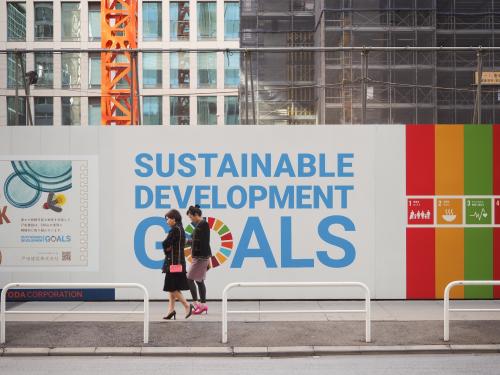Since July 2014 the price of crude oil has fallen from above $100 per barrel to below $40. This drop has brought the risks facing oil exporters into stark relief. Nowhere more so than in Africa, where there are now questions about how viable the recent oil and gas discoveries in Kenya, Tanzania, and Uganda will be. At the same time, many other African nations, including Angola, Ghana, Nigeria, and Senegal, are seeing their newly established sovereign wealth funds tested for the first time. With the volatility of oil revenues clear in people’s minds, now is a good time to discuss how such funds can be used to stabilize oil revenues and share their benefits across generations. In particular, do sovereign wealth funds make sense for all oil exporters? If so, what should they look like, and how should they be used?
There are broadly three reasons why a resource-exporter might set up a sovereign wealth fund: intergenerational transfer, parking, and stabilization. The relevance of each will depend on the country’s level of development.
Intergenerational funds
Intergenerational funds are a way for developed countries to convert below-ground natural resource assets into above-ground financial assets, like Norway’s $900 billion Government Pension Fund Global. In this way, the natural wealth is preserved for future generations. Rather than investing at home, these funds should hold a globally diversified portfolio that ideally offsets some of the country’s exposure to oil price movements. The reason is that developed countries, with ready access to international capital, should already have invested in all opportunities that yield more than the return on foreign assets. Thus, it is better to invest abroad—to diversify risk, take demand out of the economy, and limit the appreciation of the real exchange rate. In keeping with the aim of preserving wealth for future generations, the funds should make use of their long horizon to invest in assets that yield an illiquidity premium.
These intergenerational funds should have tight spending rules to preserve their capital. The rule should ideally be expressed as a fixed share of total above- plus below-ground wealth, so that it is stable over time (this is equivalent to a declining share of the fund, which represents a larger fraction of total wealth as oil is extracted). This share should be slightly below the long-run rate of return of the fund in order to incorporate some precautionary savings (discussed below).
Parking funds
While developed countries should preserve their resource wealth abroad, developing countries face more pressing needs at home. These countries need domestic investment because their cost of borrowing abroad is typically high. The financial and social rate of return on this investment is likely to be much higher than that earned on foreign assets. Adjusting the pace of oil extraction to match the ideal rate of extraction is a simple way of avoiding absorption constraints. However, this won’t typically be possible, which brings about the need for parking funds.
Parking funds are designed to temporarily hold resource revenues until they can be invested efficiently. In the early days of a resource windfall the country may have major constraints on its ability to absorb investment. For example, there is no point in investing rapidly in schools because it takes time for teachers to teach new teachers. Similarly, investing quickly in roads will drive up the cost of construction workers, so that less road is laid for every dollar spent. While these absorption constraints bind, it makes more sense to invest the revenues abroad, where they will earn a temporarily higher return.
These parking funds need different asset allocations and spending rules to those of developed countries’ intergenerational funds. Their asset allocation should focus on medium-horizon assets, because they will eventually be sold to invest at home. Their spending rule should have limits on the amount spent each year and ideally direct it to domestic investment. In practice, it is better to feed this revenue through the government budget, which is better placed to identify investments with a high social rate of return, than investing directly as a separate fund.
Stabilization funds
Risk created by volatile resource prices creates a case for saving in a stabilization fund, which receives revenues when the resource price is high. When the price falls, as in the current environment, governments will inevitably have to reign in their spending because it is very difficult to forecast when—or if—the price will rise again. Stabilization funds should be used to spread the fall in government spending over a few periods. This is so important because of the adjustment costs, or real frictions, associated with changing government spending. When commodity prices fall these costs might involve labor market frictions, with a reallocation of workers away from the public service, or nominal frictions, with a contraction in government spending. The typical response to a negative demand shock is to loosen monetary policy. However, in developing countries where monetary policy may be constrained (e.g., by a currency peg) or ineffective (e.g., because of underdeveloped financial markets), these demand shocks will distort the economy. In the present climate, countries that have planned ahead to accumulate stabilization funds can use them to smoothly adjust government spending, offsetting these distortions, without needing to turn to debt markets. However, the cost of these funds is that they should hold relatively liquid, but low-yielding, assets.
Now that the recent commodity price boom is over, many people are asking, “What do we have to show for it?” Those from countries with sovereign wealth funds will be seeing the benefit of buffering government spending. Those countries without, like Chad, Australia, and Ecuador, must use the opportunity to prepare for the future. Introducing rent taxes will have relatively little impact in the short-term, while commodity prices are low, so will face less opposition. Doing so now, and committing the revenues to sovereign wealth funds, will prepare those countries for when the next boom begins. A lesson may be learned from Norway’s experience in the late 1980s, when an oil price collapse precipitated a recession and banking crisis. There a sense that missing the opportunity of the last boom, and the pain of poor stabilization policy, helped create the political will needed to establish a now-lauded sovereign wealth fund. Hopefully the clarity of hindsight will allow others to similarly share their natural resource wealth efficiently and stably with future generations around the world.
Note: This blog reflects the views of the authors only and does not reflect the views of the Africa Growth Initiative.
The Brookings Institution is committed to quality, independence, and impact.
We are supported by a diverse array of funders. In line with our values and policies, each Brookings publication represents the sole views of its author(s).



Commentary
Resource funds: Stabilization, parking and intergenerational transfer
September 18, 2015